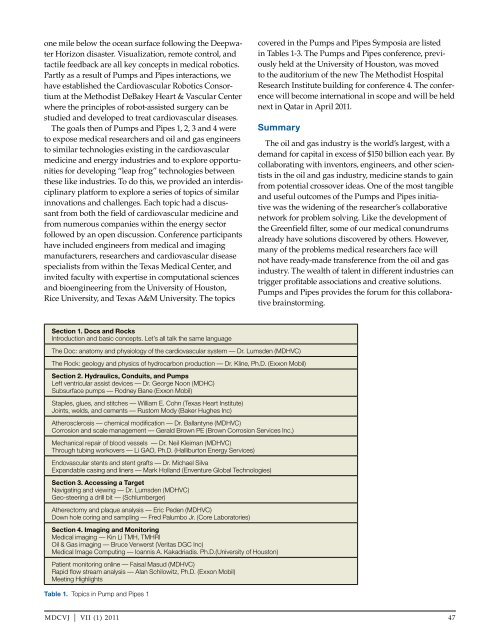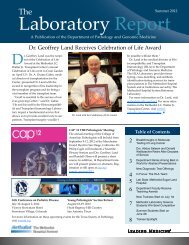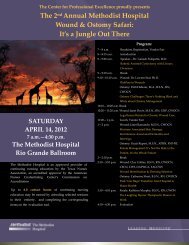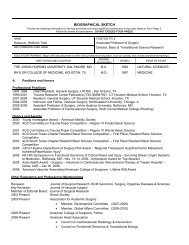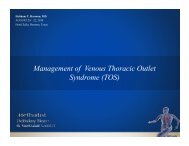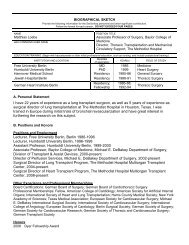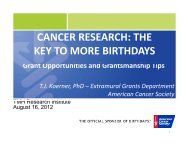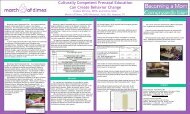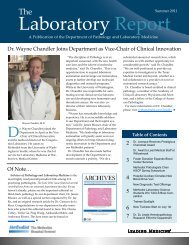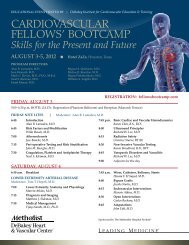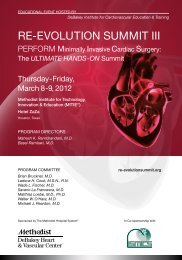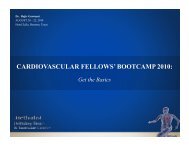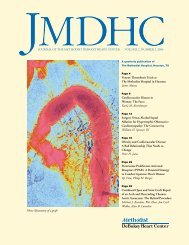DeBAKEy CARDIOvASCuLAR JOuRNAL - Methodist Hospital
DeBAKEy CARDIOvASCuLAR JOuRNAL - Methodist Hospital
DeBAKEy CARDIOvASCuLAR JOuRNAL - Methodist Hospital
You also want an ePaper? Increase the reach of your titles
YUMPU automatically turns print PDFs into web optimized ePapers that Google loves.
one mile below the ocean surface following the Deepwater<br />
Horizon disaster. visualization, remote control, and<br />
tactile feedback are all key concepts in medical robotics.<br />
Partly as a result of Pumps and Pipes interactions, we<br />
have established the Cardiovascular Robotics Consortium<br />
at the <strong>Methodist</strong> DeBakey Heart & vascular Center<br />
where the principles of robot-assisted surgery can be<br />
studied and developed to treat cardiovascular diseases.<br />
The goals then of Pumps and Pipes 1, 2, 3 and 4 were<br />
to expose medical researchers and oil and gas engineers<br />
to similar technologies existing in the cardiovascular<br />
medicine and energy industries and to explore opportunities<br />
for developing “leap frog” technologies between<br />
these like industries. To do this, we provided an interdisciplinary<br />
platform to explore a series of topics of similar<br />
innovations and challenges. Each topic had a discussant<br />
from both the field of cardiovascular medicine and<br />
from numerous companies within the energy sector<br />
followed by an open discussion. Conference participants<br />
have included engineers from medical and imaging<br />
manufacturers, researchers and cardiovascular disease<br />
specialists from within the Texas Medical Center, and<br />
invited faculty with expertise in computational sciences<br />
and bioengineering from the university of Houston,<br />
Rice university, and Texas A&M university. The topics<br />
Section 1. Docs and Rocks<br />
Introduction and basic concepts. Let’s all talk the same language<br />
The Doc: anatomy and physiology of the cardiovascular system — Dr. Lumsden (MDHVC)<br />
The Rock: geology and physics of hydrocarbon production — Dr. Kline, Ph.D. (Exxon Mobil)<br />
Section 2. Hydraulics, Conduits, and Pumps<br />
Left ventricular assist devices — Dr. George Noon (MDHC)<br />
Subsurface pumps — Rodney Bane (Exxon Mobil)<br />
Staples, glues, and stitches — William E. Cohn (Texas Heart Institute)<br />
Joints, welds, and cements — Rustom Mody (Baker Hughes Inc)<br />
Atherosclerosis — chemical modification — Dr. Ballantyne (MDHVC)<br />
Corrosion and scale management — Gerald Brown PE (Brown Corrosion Services Inc.)<br />
Mechanical repair of blood vessels — Dr. Neil Kleiman (MDHVC)<br />
Through tubing workovers — Li GAO, Ph.D. (Halliburton Energy Services)<br />
Endovascular stents and stent grafts — Dr. Michael Silva<br />
Expandable casing and liners — Mark Holland (Enventure Global Technologies)<br />
Section 3. Accessing a Target<br />
Navigating and viewing — Dr. Lumsden (MDHVC)<br />
Geo-steering a drill bit — (Schlumberger)<br />
Atherectomy and plaque analysis — Eric Peden (MDHVC)<br />
Down hole coring and sampling — Fred Palumbo Jr. (Core Laboratories)<br />
Section 4. Imaging and Monitoring<br />
Medical imaging — Kin Li TMH, TMHRI<br />
Oil & Gas imaging — Bruce Verwerst (Veritas DGC Inc)<br />
Medical Image Computing — Ioannis A. Kakadriadis. Ph.D.(University of Houston)<br />
Patient monitoring online — Faisal Masud (MDHVC)<br />
Rapid flow stream analysis — Alan Schilowitz, Ph.D. (Exxon Mobil)<br />
Meeting Highlights<br />
Table 1. Topics in Pump and Pipes 1<br />
covered in the Pumps and Pipes Symposia are listed<br />
in Tables 1-3. The Pumps and Pipes conference, previously<br />
held at the university of Houston, was moved<br />
to the auditorium of the new The <strong>Methodist</strong> <strong>Hospital</strong><br />
Research Institute building for conference 4. The conference<br />
will become international in scope and will be held<br />
next in Qatar in April 2011.<br />
Summary<br />
The oil and gas industry is the world’s largest, with a<br />
demand for capital in excess of $150 billion each year. By<br />
collaborating with inventors, engineers, and other scientists<br />
in the oil and gas industry, medicine stands to gain<br />
from potential crossover ideas. One of the most tangible<br />
and useful outcomes of the Pumps and Pipes initiative<br />
was the widening of the researcher’s collaborative<br />
network for problem solving. Like the development of<br />
the Greenfield filter, some of our medical conundrums<br />
already have solutions discovered by others. However,<br />
many of the problems medical researchers face will<br />
not have ready-made transference from the oil and gas<br />
industry. The wealth of talent in different industries can<br />
trigger profitable associations and creative solutions.<br />
Pumps and Pipes provides the forum for this collaborative<br />
brainstorming.<br />
MDCvJ | vII (1) 2011 47


